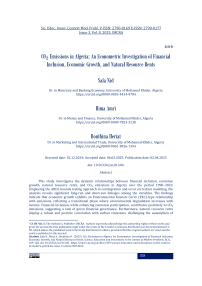CO₂ Emissions in Algeria: An Econometric Investigation of Financial Inclusion, Economic Growth, and Natural Resource Rents
Автор: Safa N., Rima A., Bouthina H.
Журнал: Science, Education and Innovations in the Context of Modern Problems @imcra
Статья в выпуске: 3 vol.8, 2025 года.
Бесплатный доступ
This study investigates the dynamic relationships between financial inclusion, economic growth, natural resource rents, and CO₂ emissions in Algeria over the period 1990–2023. Employing the ARDL bounds testing approach to cointegration and error correction modeling, the analysis reveals significant long-run and short-run linkages among the variables. The findings indicate that economic growth exhibits an Environmental Kuznets Curve (EKC)-type relationship with emissions, reflecting a transitional phase where environmental degradation increases with income. Financial inclusion, while enhancing economic participation, contributes positively to CO₂ emissions, suggesting a lack of green financial governance. Furthermore, natural resource rents display a robust and positive correlation with carbon emissions, challenging the assumption of resource-led sustainability and highlighting deficiencies in resource revenue management. These results underscore the need for policy integration between financial and environmental systems. The study recommends the implementation of green financial policies, such as environmentally conditional credit frameworks, investment in renewable energy infrastructure, and the establishment of a sovereign wealth fund dedicated to sustainable development. By addressing these dimensions, Algeria can reconcile economic advancement with its climate commitments and move towards a low-carbon, inclusive growth model.
Financial inclusion, CO₂ emissions, Natural resource rents, Environmental Kuznets Curve, ARDL model, Algeria
Короткий адрес: https://sciup.org/16010480
IDR: 16010480 | DOI: 10.56334/sei/8.3.06


